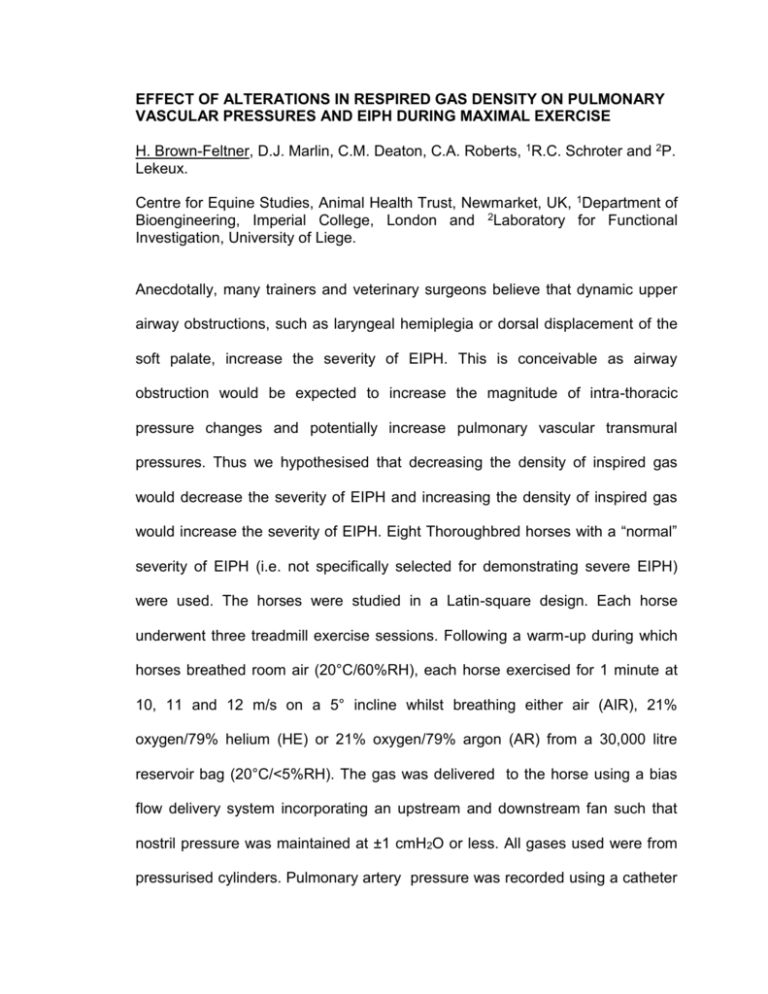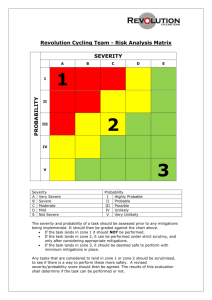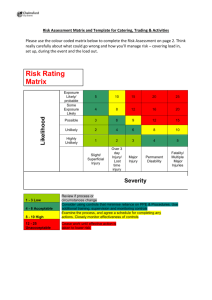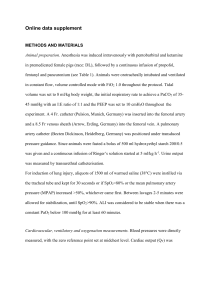Effect of alternations in respired gas density on pulmonary vascular
advertisement

EFFECT OF ALTERATIONS IN RESPIRED GAS DENSITY ON PULMONARY VASCULAR PRESSURES AND EIPH DURING MAXIMAL EXERCISE H. Brown-Feltner, D.J. Marlin, C.M. Deaton, C.A. Roberts, 1R.C. Schroter and 2P. Lekeux. Centre for Equine Studies, Animal Health Trust, Newmarket, UK, 1Department of Bioengineering, Imperial College, London and 2Laboratory for Functional Investigation, University of Liege. Anecdotally, many trainers and veterinary surgeons believe that dynamic upper airway obstructions, such as laryngeal hemiplegia or dorsal displacement of the soft palate, increase the severity of EIPH. This is conceivable as airway obstruction would be expected to increase the magnitude of intra-thoracic pressure changes and potentially increase pulmonary vascular transmural pressures. Thus we hypothesised that decreasing the density of inspired gas would decrease the severity of EIPH and increasing the density of inspired gas would increase the severity of EIPH. Eight Thoroughbred horses with a “normal” severity of EIPH (i.e. not specifically selected for demonstrating severe EIPH) were used. The horses were studied in a Latin-square design. Each horse underwent three treadmill exercise sessions. Following a warm-up during which horses breathed room air (20°C/60%RH), each horse exercised for 1 minute at 10, 11 and 12 m/s on a 5° incline whilst breathing either air (AIR), 21% oxygen/79% helium (HE) or 21% oxygen/79% argon (AR) from a 30,000 litre reservoir bag (20°C/<5%RH). The gas was delivered to the horse using a bias flow delivery system incorporating an upstream and downstream fan such that nostril pressure was maintained at ±1 cmH2O or less. All gases used were from pressurised cylinders. Pulmonary artery pressure was recorded using a catheter tip micro-manometer positioned 8 cm distal to the pulmonic valve. Oesophageal pressure was recorded by a catheter tip micro-manometer positioned 4 cm caudal to the back of the heart. Stride frequency was determined from oscillations in the differential pressure recorded in the bias flow. BAL of the left and right dorsal-caudal lobes was carried out at 40 min post-exercise. All horses completed the full protocol on HE and AIR, but on AR run time on the final 12m/s step was 38-56 seconds before fatigue. Mean pulmonary artery pressure at 12 m/s was not different between HE (86 ± 15), AIR (85 ± 8) and AR (88 ± 12 mmHg). Mean maximum delta oesophageal pressure at 12 m/s was significantly reduced on HE (70 ± 21) compared with AIR (111 ± 21) and AR (118 ± 12 cmH2O). However, mean pulmonary artery transmural pressure at 12 m/s was not different between treatments (HE 90 ± 12; AIR 91 ± 8; AR 87 ± 10 mmHg). Total RBC counts (sum of counts in left and right lung) were 10,199 ± 10,704 (HE), 7,796 ± 7,132 (AIR) and 11,701 ± 9,136 (AR) RBC/ul BAL. Across all treatments, the severity of EIPH was significantly higher in the left (6,248 ± 5,804 RBC/ul BAL) compared with the right lung (3,650 ± 3,206 RBC/ul BAL; P=0.0015). Both HE and AR increased the severity of EIPH compared with AIR. The mechanism is unclear as mean pulmonary artery transmural pressure was unchanged by treatment. The increase in severity of EIPH with HE is also interesting as maximum delta oesophageal pressure was decreased.









